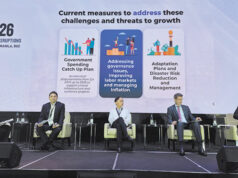Optimizing agri sector’s potential through tech
By Mark Louis F. Ferrolino, Special Features Writer
The Philippines continues to exhibit a stellar economic performance in recent years, making it one of the fastest-growing economies in the world. Amidst rising global uncertainties, the economy remains strong and is projected to grow at 5.8% this year, according to The World Bank. But despite this, the country’s agriculture sector is left struggling to meet its full potential, recording a steady decline in terms of contribution to the gross domestic product (GDP) over the years.
In 1980, agriculture accounted for about one-fourth of the nation’s GDP. This has dwindled as the country gradually shifted from an agrarian to an industrial and service-oriented economy. At present, the sector represents a thin share of the country’s total GDP. In 2018, Agriculture, Hunting, Forestry and Fishing (AHFF) comprised only 8.1% of the national economy, the Philippine Statistics Authority (PSA) stated.
For Jet Parma, president and country head of Syngenta Philippines, Inc., an affiliate of a leading global agricultural company that offers crop protection products and seeds, agriculture is still an important contributor to the Philippine economy.
He told BusinessWorld in an e-mail that the sector remains crucial for food production and security. It also employs a significant portion of the country’s labor force. In fact, in rural areas, agriculture is still the main source of livelihood and employment, he said.
Based on the latest data released by the PSA, workers in the agriculture sector comprised the second largest proportion of the country’s total employed population in July 2019. These workers made up 23.5% of the total employed, following workers in the services sector that accounted for 57.8%.
There are several challenges that the local agriculture sector is facing which hamper its growth. Limited diversification, low productivity, climate change, and natural resource degradation are some of these.
According to Mr. Parma, factors that hinder productivity include limited access to credit, lack of farm mechanization, irrigation problems, unavailability of post-harvest facilities, ageing farmers, loss of agricultural land, and inadequate farm to market roads.
From April to June of 2019, the PSA reported that the country’s agricultural output contracted by 1.27%, which was attributed to the decline in crops production. Increases, however, were recorded for livestock, poultry and fisheries. At current prices, the value of agricultural production amounted to P424.6 billion, 5.2% lower than the previous year’s level, the PSA said.
Climate change is another major challenge. “Strong typhoons and drought affect planting resulting in poor quality yield,” Mr. Parma said.
Siimilar to other industries, the agriculture sector is not new to change brought by advances in technology. Unsurprisingly, these developments have also helped address some of the challenges of the sector.
In particular, some of the recent innovations in the sector that have helped farmers in their farming practices, according to Mr. Parma, include the introduction of hybrid seeds that are not only insect- and disease-resistant but are also resilient to climate change; crop protection products that are low dose and have multi-site mode of action; use of hand tractor, harvester and planter to address issues on manual labor; solar-powered irrigation systems; use of drones to safely and efficiently apply crop protection products; and mobile applications that help identify crops and diagnose possible field problems.
Though adoption of technology in the local agriculture sector has improved compared to previous years, Mr. Parma said that uptake has been slow and a lot of work still needs to be done.
“There is a need to educate more farmers on how to grow their crops more efficiently. Learning centers or demo sites are helpful as farmers need to see for themselves that new solutions or technology bring better yield and higher RoI (return on investment),” he said.
Mr. Parma added that the government has always been openly supportive of the agricultural sector.
“Several programs were created to address low productivity and improve our competitiveness in the world market. However, the problem has always been in the implementation of these programs,” he said.
In the years to come, Mr. Parma sees an increased adoption of new technology in the sector.
“The population continues to increase but resources remain the same. Land used to produce food will not get any bigger. We have no option but to grow with less. The country should also be less dependent on imports as global supply is also thinning. Innovation and technology are key in order for this sector to accelerate its growth,” he said.



